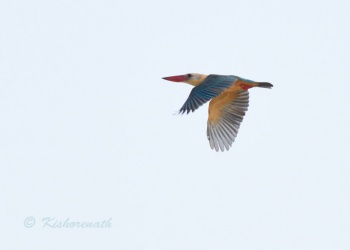- Pelargopsis capensis
Halcyon capensis
Identification

Photo © by Alok Tewari
Amboli Ghat, Alt. 2265 ft., Western Ghat, Dist. Sindhudurg, Maharashtra, India, February-2019
35–41 cm (13¾-16¼ in). A very large tree kingfisher.
Adult: green back, blue wings and tail, light brown head, buffy-orange underparts; very large bright red bill, orange-red eye ring, legs also red.
Sexes are similar.
Variation
Subspecies differ in plumage, for instance, P.c. gigantea found in the Sulu Islands, has a white head, neck and underparts[3]:
Similar Species
The very large red bill makes it unmistakable.
Distribution
Tropical south Asia from India and Sri Lanka, through SE Asia to Indonesia.
Taxonomy
Previously Halcyon capensis.
Subspecies

Photo © by darwin1601
Kinabatangan River, Sabah, Borneo, Malaysia, November 2018
Clements recognizes these subspecies[1]:
- P. c. capensis from Nepal to India, Sri Lanka and north-western Myanmar
- P. c. burmanica from Myanmar to Thailand, Indochina and south to Isthmus of Kra
- P. c. intermedia on the Nicobar Islands
- P. c. osmastoni on the Andaman Islands
- P. c. malaccensis on the South Malay Peninsula, Riau Archipelago and Lingga Archipelago
- P. c. cyanopteryx on Sumatra, Bangka and Billiton islands
- P. c. simalurensis on Simeulue Island (off north-western Sumatra)
- P. c. sodalis on Banyak, Nias, Batu, and Mentawai islands (off western Sumatra)
- P. c. innominata on Borneo
- P. c. floresiana on the Lesser Sundas (Bali, Lombok, Sumbawa and Flores)
- P. c. javana on Java
- P. c. gouldi on the Philippines (Balabac, Culion, Lubang, Mindoro, Palawan, Calauit)
- P. c. gigantea (smithi) in Central and southern Philippines
Habitat
Forested areas near lakes, rivers and coasts.
Behaviour
Very territorial and will chase off large predators, such as eagles.
Diet
They will perch quietly while hunting fish, crabs, frogs, rodents and young birds.
Action
Flight is direct, but rather labored and flapping.
Breeding
They dig a hole for its nest in a river bank, rotten tree or tree termite nest, where the female lays 2-5 round, white eggs.
Vocalisation
This is a noisy kingfisher, giving a low and carrying peer-por-por about every 5 seconds, and also a cackling ke-ke-ke-ke-ke-ke.
References
- Clements, J. F., P. C. Rasmussen, T. S. Schulenberg, M. J. Iliff, T. A. Fredericks, J. A. Gerbracht, D. Lepage, A. Spencer, S. M. Billerman, B. L. Sullivan, M. Smith, and C. L. Wood. 2024. The eBird/Clements checklist of Birds of the World: v2024. Downloaded from https://www.birds.cornell.edu/clementschecklist/download/
- Gill, F, D Donsker, and P Rasmussen (Eds). 2024. IOC World Bird List (v 14.2). Doi 10.14344/IOC.ML.14.2. http://www.worldbirdnames.org/
- Handbook of the Birds of the World Alive (retrieved November 2018)
Recommended Citation
- BirdForum Opus contributors. (2025) Stork-billed Kingfisher. In: BirdForum, the forum for wild birds and birding. Retrieved 2 May 2025 from https://www.birdforum.net/opus/Stork-billed_Kingfisher
External Links
GSearch checked for 2020 platform.1





